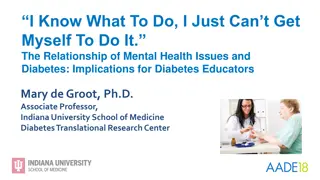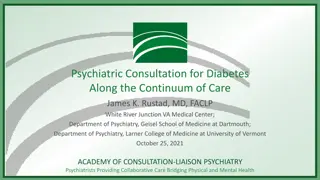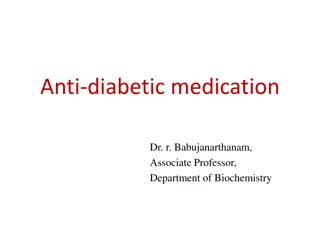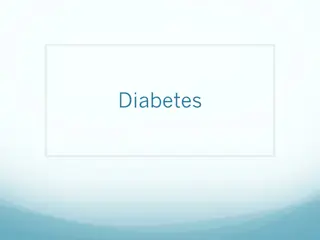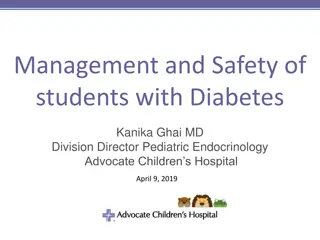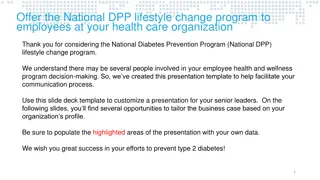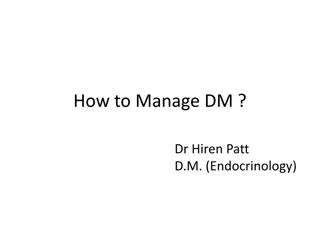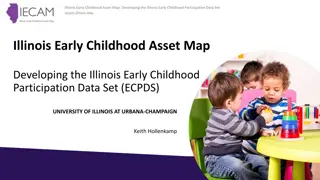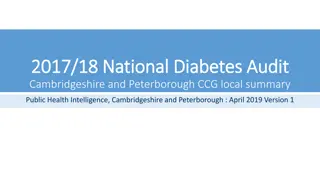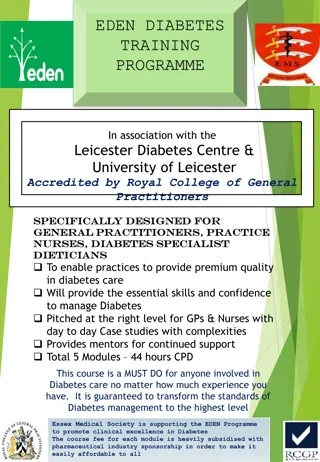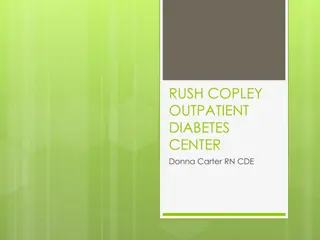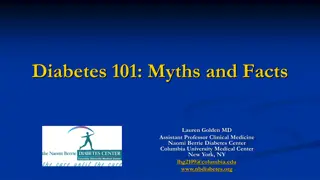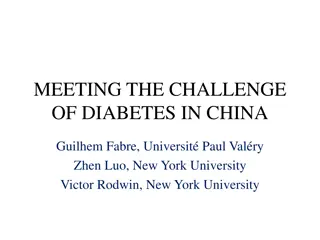5th Childhood Diabetes Prevention Symposium: The Early Start Study by Dr. Tess Brigitte I. Frohnert
The 5th Childhood Diabetes Prevention Symposium discusses the Trial of Early Initiation of CGM-Guided Insulin Therapy in Stage 2 T1D, focusing on the background, goals, and protocol of the study. The symposium aims to minimize dysglycemia, avoid adverse outcomes, and optimize education through early intervention and CGM-guided learning. The TESS design involves a randomized controlled trial with intensive follow-up utilizing CGM technology. The protocol includes unblinded CGM-guided education and monthly evaluation of data. Outcomes will be measured through glycemic measures, beta-cell function markers, knowledge, quality of life, and cost analysis.
Download Presentation

Please find below an Image/Link to download the presentation.
The content on the website is provided AS IS for your information and personal use only. It may not be sold, licensed, or shared on other websites without obtaining consent from the author. Download presentation by click this link. If you encounter any issues during the download, it is possible that the publisher has removed the file from their server.
E N D
Presentation Transcript
5th Childhood Diabetes Prevention Symposium The Early Start Study: TESS BRIGITTE I. FROHNERT MD PHD November 11, 2022
Outline 1. Background and goals 2. TESS protocol 3. Baseline data from TESS participants 4. Intermediate data from TESS participants 5. Presymptomatic T1D and EMR communication
Rationale for TESS (Trial of Early Initiation of CGM-Guided Insulin Therapy in Stage 2 T1D) Currently no guidelines for management of stage 2 T1D OGTT and HbA1c present challenges for monitoring Continuous Glucose Monitor (CGM) opportunities: Therapeutic decisions Teaching patients and families from real-world data
Goals Minimize dysglycemia: Maintain HbA1c <7.0%. Peak HbA1c during study CGM values at 6 and 12 months after enrollment Avoid adverse outcomes: ER visits, hospitalizations, DKA and severe hypoglycemia
Goals Optimize education: Early education before symptomatic/ on insulin CGM-guided learning Experience: Patient/caregiver satisfaction Quality of life
TESS Design and Study Population Randomized controlled trial Intensive follow-up of stage 2 T1D participants utilizing continuous CGM technology and early education of families to guide early insulin therapy Target 36 participants (31 enrolled to date) Randomized 2:1 (intervention:control) 6 months intervention/6 months follow-up Intervention: CGM-guided education and initiation of insulin
TESS Protocol Intervention (6 months): Unblinded CGM-guided education Monthly evaluation of CGM data CGM-guided insulin start (verification by glucometer) Control Monitoring by intermittent finger stick glucose Standard review of symptoms
Outcomes Glycemic measures CGM data collection every 3 months OGTT at 0, 6, 12 months Collection of markers of beta-cell function Knowledge Quality of life Cost analysis
Enrollment Criteria ADA Criteria for Stage 2 T1D OGTT (plasma glucose) Fasting 2 hour glucose A1c At visit Increase from last visit Age 2 to 20 years Islet autoimmunity with high risk of progression: Multiple IA positive (>50% 5-year risk) Single high-affinity IA (>30% 5-year risk) 100-125 mg/dL 140-199 mg/dL 5.7-6.4% >10% Additional TESS Criteria for Stage 2 T1D OGTT (plasma glucose) 30, 60 or 90 min glucose CGM (worn for > 5 days) Average sensor glucose % time above 140 mg/dl Peaks 200 mg/dl Home glucometer: Fasting BG 2-hour post meal BG Single random BG >200 mg/dL Dysglycemia: ADA criteria CGM-based criteria Home glucose testing data >120 mg/dL 15% on 2 days >110 mg/dL on 2 days >150 mg/dL on 2 days > 200 mg/dL
Qualifying Dysglyemia in TESS Participants A1c 20% HGT 7% OGTT 10% CGM/OGTT 10% A1c/CGM 7% CGM 46% HGT: Home glucose testing 10
Participant eligibility Eligibility Criteria for Dysglycemia Control (N=11) Intervention (N=19) P-value Eligibility visit (weeks before baseline) 14.1 11.2 14.0 13.5 0.98 HbA1c (5.7-6.4%) 18% (2) 32% (6) 0.67 CGM 64% (7) 63% (12) 0.98 OGTT 40% (4) 13% (2) 0.18 Home glucose testing 20% (2) 22% (5) 1 Multiple abnormal measures 36% (4) 26% (5) 0.56
TESS Baseline Demographic Data Baseline Characteristics Controls (N=11) Intervention (N=19) P-value Age (years) Female, % (n) 1st degree relative w/ T1D 14.6 3.6 64% (7) 10.1 3.7 53% (10) 0.01 0.56 36% (4) 42% (8) 0.76 BMI Z-score TG antibody positive, % (n) 0.3 1.4 18% (2) 0.2 1.4 21% (4) 0.77 0.90
TESS Baseline Glycemic Data Baseline Characteristics Controls (N=11) Intervention (N=19) P-value HbA1c at baseline (%) 5.2 0.3 5.4 0.4 0.14 CGM at baseline %Time >140 mg/dL average SG (mg/dL) 10.0 13.0 112 14 11.5 8.7 114 9 0.74 0.65 OGTT at baseline Fasting glucose (mg/dL) 89 11 85 10 0.36 Peak 30,60,90 glucose (mg/dL) 186 35 183 59 0.91 2h glucose (mg/dL) 116 26 151 57 0.06
Early-stage T1D education MD/NP: Pathophysiology of T1D CGM-guided education (diet/exercise) Trends with illness (Insulin plan) RD: Dietary education: Carbs and healthy diet Exercise CDE: Practical education: Use of CGM, troubleshooting Symptoms of highs and lows Checking ketones/Illness (Glucagon) SW: Emotional/Family impacts Family strengths Depression/anxiety Coping and grief
T1D Diagnosis Baseline Characteristics Controls (N=11) Intervention (N=19) P-value Diagnosed, % (n) Age (years) 18% (2) 14.8 5.4 32% (6) 10.4 4.6 0.67* 0.30 HbA1c at diagnosis (%) 5.5 0.4 5.6 0.4 0.60 Time after enrollment (months) 7.5 10.6 3.5 3.7 0.41 *Fisher s exact test
DIABETES KNOWLEDGE 35 P=0.049 30 25 20 15 10 5 6 15 3 10 2 4 0 BASELINE 6M 12M CONTROL INTERVENTION
Development of new problem list entries Collaboration with Children s Colorado Epic team Intelligent Medical Objects (IMO) health informatics serving: EHR and Point of Care Solutions Clinical Research Organizations Health Information Exchanges (HIEs) Health Data and Analytic Vendors American Health Information Management Association (AHIMA) Global nonprofit association of health information professionals
Stage-related Problems and Risk summary Persistent single high-affinity islet autoantibody (R76.8 abnormal immunological findings) Stage 1 presymptomatic normoglycemic type 1 prediabetes (R73.03 - prediabetes) Stage 2 presymptomatic dysglycemic type 1 prediabetes (R73.03 - prediabetes) NAME has presymptomatic type 1 diabetes mellitus (and has shown dysglycemia on previous measures). HE/SHE is at risk for progression to clinical diabetes and diabetic ketoacidosis.
Currently visible in patient chart Research memo with consent for ASK Lab order placed as Research Only Order Results viewable to all with flag for abnormal and text narrative of risk. Problem list with linked overview containing details and recommendations
Clinical decision support: Best Practice Advisory (BPA) Goal: address potential care gaps: Recognize presymptomatic T1D and associated risks Assessment for acute care visits Solution: presymptomatic T1D problem list codes will trigger BPA: Assessment of risk Recommendations Associated order set to be used at provider discretion
Advice and order set Consider HbA1c, blood and/or urine glucose and ketones during illness. Please page Barbara Davis Center physician with questions or if labs show ketosis, HbA1c 6.5, or glucose >200 mg/dL. Optional order set (pick list) HbA1c POC blood glucose Dipstick urinalysis: for glucose and ketones
Future Directions Current mapping to ICD-10 codes is somewhat problematic Definition of Prediabetes is based on evolution of type 2 diabetes Type 1 diabetes stage 2 definition is similar but distinct. This will likely continue to evolve (CGM data or other biomarkers) Anticipate increased screening as potential for intervention increases (Teplizumab) IMO working on request to Centers for Medicare & Medicaid Services (CMS) for developing T1D-specific ICD-10 codes.
Acknowledgements BDC Cristy Geno Rasmussen Judy Baxter Flor Sepulveda Kim Bautista Brigitte Frohnert Liping Yu Andrea Steck Kim Bautista Kathy Waugh Tricia Gesualdo Kimber Simmons Danny Felipe- Morales Sponsors Brett McQueen Fran Dong David Roth Rick Bacher Jill Norris Jeffrey Krischer 5-ECR-2017-388-A-N G-1911-03463 Patten-Davis Foundation Partners Edwin Liu, Marisa Stahl Erin Sandene Kevin Carney, Suzy Jaeger Amy Lewis, Chrisann Karr Willy Boucharel, Stephanie Beling Sondra Valdez, Chris Martin Arleta Rewers, Alison Brent Michael Narkewicz Dan Feiten Tracy Brekken Martha Middlemist Rebekah Phillips Kathy Love-Osborne Holly Frost
Decision Points for Early Initiation of Insulin 1. Is there an ongoing pattern of elevated glucose? 2. What is typical pattern? Peak with largest meal? Elevation across the day or with multiple meals? 3. What is overnight trajectory? Would Long-acting insulin cause early morning lows?


